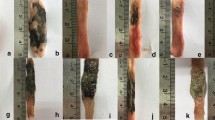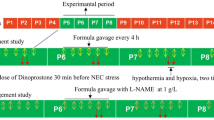Abstract
Multiple mucosal immune factors, such as TNF-α and IL-1β, are thought to be key mediators involved in inflammatory bowel disease. We evaluated the role of the pro-inflammatory cytokine TNF-α on nitric oxide synthase (NOS) expression in indomethacin-induced jejunoileitis in rats. Jejunoileitis was induced in rats with subcutaneous injections of indomethacin (7.5 mg/kg) 24 h apart for two consecutive days, and animals were randomized into four groups. Group 1 received only indomethacin. Group 2 was treated with a daily dose of phosphodiesterase (PDE) inhibitor (theophylline or pentoxifylline) by oral gavage for 2 days before and 4 days after indomethacin. Group 3 received a single dose of anti-TNF-α monoclonal antibody (TNF-Ab, IP) 30 min before indomethacin. Group 4 was treated with 1 h hyperbaric oxygenation (HBO2) for 5 days after indomethacin. Rats were sacrificed at 12 h or 4 days after final indomethacin injection. PDE inhibitor, TNF-Ab, or HBO2 treatment significantly decreased indomethacin-induced ulceration, myeloperoxidase activity, and disease activity index. Although indomethacin significantly increased serum TNF-α and nitrate/nitrite (NOx) concentrations above control values at 12 h, inducible NOS (iNOS) expression was detected only at day 4. Serum IL-1β levels did not change at 12 h but increased 4-fold after 4 days. Indomethacin had no effect on constitutive NOS. Treatment with PDE inhibitor, TNF-Ab, or HBO2 significantly reduced serum/tissue TNF-α, IL-1β, NOx, and iNOS expression. Our data show TNF-α plays an early pro-inflammatory role in indomethacin-induced jejunoileitis. Additionally, down-regulation of NOx by PDE inhibitors, TNF-Ab, or HBO2 suggests that TNF-α modulates iNOS expression.






Similar content being viewed by others
References
Podolsky DK (2000) Medical progress: inflammatory bowel disease. N Engl J Med 347:417–429
Akazawa A, Sakaida I, Higaki S, Kubo Y, Uchida K, Okita K (2002) Increased expression of tumor necrosis factor-alpha messenger RNA in the intestinal mucosal of inflammatory bowel disease, particularly in patients with disease in the inactive phase. J Gastroenterol 37:345–353
Bertrand V, Guimbund R, Tulliez M, Mauprivez C, Sogni P, Couturier D, Giroud JP, Chaussade S, Chauvelot-Moachon L (1998) Increase in tumor necrosis factor-α production linked to toxicity of indomethacin in the rat small intestine. Br J Pharmacol 124:1385–1394
Grisham MB, Pavlic KP, Laroux FS, Hoffnan J, Bharwani S, Wolf RE (2002) Nitric oxide and chronic gut inflammation: controversies in inflammatory bowel disease. J Invest Med 50:272–283
Baeverle PA, Baltimore D (1996) NF-KB: ten years after. Cell 87:13–20
Colon AL, Menchen L, Lizasoain I, Leza JC, Menchen P, Gonzalez-Lara V, Moro MA, Lorenzo P (2000) Inducible nitric oxide synthase activity is expressed not only in inflamed but also in normal colonic mucosa in patients with ulcerative colitis: a potential prognostic marker. Am J Gastroenterol 95:1371–1372
Konaka A, Nishijima M, Tanaka A, Kunikata T, Kato S, Tekeuchi K (1999) Nitric oxide, superoxide radicals and mast cells in pathogenesis of indomethacin-induced small intestinal lesions in rats. J Physiol Pharmacol 50:25–38
Whittle BJR, Laszlo F, Evans SM, Moncada S (1995) Induction of nitric oxide synthase and microvascular injury in the rat jejunum provoked by indomethacin. Br J Pharmacol 116:2286–2290
Singer II, Kawka DW, Scott S, Weidner JR, Mumford RA, Riehl TE, Stenson WF (1996) Expression of inducible nitric oxide synthase and nitrotyrosine in colonic epithelium in inflammatory bowel disease. Gastroenterology 111:871–885
Kimura H, Miura S, Shigematsu T, Ohkubo N, Tsuzuki Y, Kurose I, Higuchi H, Akiba Y, Hokari R, Hirokawa M, Serizawa H, Ishii H (1997) Increased nitric oxide production and inducible nitric oxide synthase activity in colonic mucosa of patients with active ulcerative colitis and Crohn’s disease. Dig Dis Sci 42:1047–1054
Grisham MB, Jourd’heuil D, Wink DA (1999) Nitric oxide I physiological chemistry of nitric oxide and its metabolites: implication in inflammation. Am J Physiol 276:G315–G321
Miller MJS, Sandoval M (1999) Nitric oxide III A molecular prelude to inflammation. Am J Physiol 276:G795–G799
Parasher G, Frenklakh L, Siddiqui T, Nandi J, Levine RA (2001) Nitric oxide inhibitors ameliorate indomethacin-induced enteropathy in rats. Dig Dis Sci 46:2536–2541
Nandi J, Saud B, Zinkievich JM, Palma DT, Levine RA (2008) 5-aminosalicylic acid improves indomethacin-induced enteropathy by inhibiting iNOS transcription in rats. Dig Dis Sci 53:123–132
Rachmilewitz D, Karmeli F, Okon E, Bursztyn M (1995) Experimental colitis is ameliorated by inhibition of nitric oxide synthase activity. Gut 37:247–255
Shanahan F (2001) Inflammatory bowel disease: immunodiagnostics, immunotherapeutics, and ecotherapeutics. Gastroenterology 120:622–635
Lugering A, Schmidit M, Lugering N, Pauels HG, Domschke W, Kucharzik T (2001) Infliximab induces apoptosis in monocytes from patients with chronic active Crohn’s disease by using a caspase-dependent pathway. Gastroenterology 121:1145–1157
Santucci L, Fiorucci S, Giansanti M, Buonori PM, DiMatteo FM, Morelli A (1994) Pentoxifylline prevents indomethacin induced acute mucosal damage in rats: role of tumour necrosis factor alpha. Gut 35:909–915
Weisz G, Lavy A, Adir Y, Melamed Y, Rubin D, Eidelman S, Pollack S (1997) Modification of in vitro and in vivo TNF-alpha, IL-1, and IL-6 secretion by circulating monocytes during hyperbaric oxygen treatment in patients with perianal Crohn’s disease. J Clin Immunol 17:154–159
Grisham MB, Benoit JN, Granger DN (1996) Assessment of leukocyte involvement during ischemia and re-perfusion of intestine. Methods Enzymol 186:729–742
Kennedy M, Wilson L, Szabo C, Salzman AL (1999) 5-aminosalicylic acid inhibits iNOS transcription in human intestinal epithelial cells. Int J Mol Med 4:437–443
Anthony A, Pounder RE, Dhillon AP, Wakefield AJ (2001) The inflammatory bowel disease study group. Similarities between ileal Crohn’s disease and indomethacin experimental jejunal ulcers in the rat. Aliment Pharmacol Ther 14:241–245
Yamada T, Deitch E, Specian RD, Perry MA, Sartor RB, Grisham MB (1993) Mechanisms of acute and chronic intestinal inflammation induced by indomethacin. Inflammation 17:641–662
Videla S, Garcia-Lafuente A, Antolin M, Vilaseca J, Guarner F, Crespo E, Lez GG, Salas A, Malagelada JR (1998) Antitumor necrosis factor therapy in rat chronic granulomatous colitis: critical dose-timing effects on outcome. J Pharmacol Exp Ther 287:854–859
Sukumar P, Loo A, Adolphe R, Nandi J, Oler A, Levine RA (1999) Dietary nucleotides augment dextran sulfate sodium-induced distal colitis in rats. J Nutr 129:1377–1381
Nandi J, Meguid MM, Inui A, Xu Y, Makarenko IG, Tada T, Chung C (2002) Central mechanisms involved with catabolism. Curr Opin Clin Nutr Metab Care 5:407–418
Saito K, Tanaka Y, Ota T, Eto S, Yamashita U (1991) Suppressive effect of hyperbaric oxygenation on immune responses of normal and autoimmune mice. Clin Exp Immunol 86:322–327
Doherty GM, Christian J, Alexander HR, Buresh CM, Norton JA (1991) Pentoxifylline suppression of tumor necrosis factor gene transcription. Surgery 110:192–198
Reuter BK, Wallace JL (1999) Phosphodiesterase inhibitors prevent NSAID enteropathy independently of effects on TNF-α release. Am J Physiol 277:G847–G854
Katz J, Willis J, Cooper G, Geraci K, Fiocchi C (1999) Treatment of Crohn’s disease with pentoxifylline: lack of correlation between clinical improvement and mucosal cytokine levels. Am J Gastroenterol 94:A270
Reimund JM, Dumont S, Muller CD, Kenney JS, Kedinger M, Baumann R, Poindron P, Duclos B (1997) In vitro effects of oxpentifylline on inflammatory cytokine release in patients with inflammatory bowel disease. Gut 40:475–480
Lopez-Belmonte J, Whittle BJR, Moncada S (1993) The actions of nitric oxide donors in the prevention of induction of injury to the rat gastric mucosa. Br J Pharmacol 108:73–78
Takeuchi K, Yokota A, Tanaka A, Takahira Y (2006) Factors involved in upregulation of inducible nitric oxide synthase in rat small intestine following administration of nonsteroidal anti-inflammatory drugs. Dig Dis Sci 51(7):1250–1259
Robert A, Asano T (1977) Resistance of germ free rats to indomethacin-induced intestinal lesions. Prostaglandins 14:333–341
Tenenhaus M, Hansbrough JF, Zapata-Sirvent R, Neumann T (1994) Treatment of burned mice with hyperbaric oxygen reduces mesenteric bacteria but not pulmonary neutrophil deposition. Arch Surg 129:1338–1342
Gottlieb SF (1971) Effect of hyperbaric oxygen on microorganisms. Annu Rev Microbiol 25:111–152
Sebesteny M, Balogh A, Nemes A, Besznyak I (1976) Effect of hyperbaric oxygen on aerobic bacteria. Z Exp Chir 9:84–88
Author information
Authors and Affiliations
Corresponding author
Rights and permissions
About this article
Cite this article
Nandi, J., Saud, B., Zinkievich, J.M. et al. TNF-α modulates iNOS expression in an experimental rat model of indomethacin-induced jejunoileitis. Mol Cell Biochem 336, 17–24 (2010). https://doi.org/10.1007/s11010-009-0259-2
Received:
Accepted:
Published:
Issue Date:
DOI: https://doi.org/10.1007/s11010-009-0259-2




